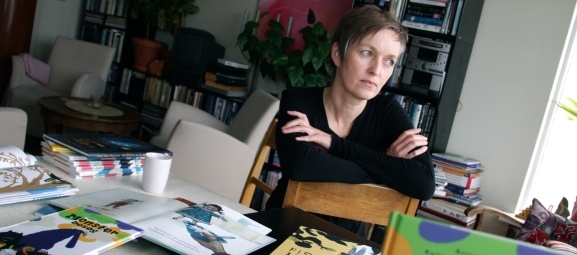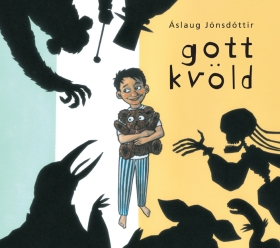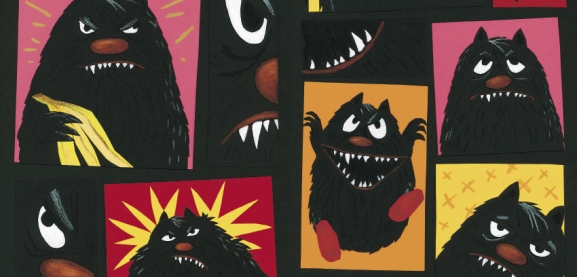Áslaug Jónsdóttir
Monsters at the proper temperature
“Each picture book needs to strike the right temperature, the right mood,” says author and artist Áslaug Jónsdóttir, whose visually striking and atmospheric books have enthralled children and adults alike for the past decade.

“Each picture book needs to attain the proper temperature, the proper mood,” says author and artist Áslaug Jónsdóttir, whose visually striking and atmospheric books have enthralled children and adults alike for the past decade.
The three books I see lying on her living room table turn out to be three version of the same work: her newest book – in Icelandic, Swedish and Faroese – fresh from the printing press.
“They're not translations,” she tells me when I mention them. “The new book was published simultaneously in three languages. And even though the three editions tell the same story, their texts are all slightly different.”
 The new book, Skrímsli á toppnum (lit. Monsters at the Top) is the sixth book featuring monsters by Áslaug and the other two authors - Kalle Guettler from Sweden and Rakel Heimisdal from the Faeroe Islands. The first book appeared in 2004. For a decade now, Áslaug has also written and illustrated books on her own. Her story Gott kvöld (Good Evening), the story of a young boy who learns to overcome his fear of the dark, was produced as a popular play in the National Theater in 2005, and now she is working on a stage adaption of the monster series.
The new book, Skrímsli á toppnum (lit. Monsters at the Top) is the sixth book featuring monsters by Áslaug and the other two authors - Kalle Guettler from Sweden and Rakel Heimisdal from the Faeroe Islands. The first book appeared in 2004. For a decade now, Áslaug has also written and illustrated books on her own. Her story Gott kvöld (Good Evening), the story of a young boy who learns to overcome his fear of the dark, was produced as a popular play in the National Theater in 2005, and now she is working on a stage adaption of the monster series.
“It's hard to tell how it's going,” she says hesitantly when I ask about the play. “The monsters and all that happens to them are good material for the stage. I feel that I know these characters completely. But I'm still learning about the theater. It's hard to write without visualizing each scene completely, literally picturing the eventual outcome. In my mind, the monsters are already bounding onto and off the stage, regardless of whether they'll actually make it there or not.”
It's always prudent to speak carefully about unwritten work. But your collaboration with the other authors on the monster books is interesting. There are actually three authors to each book?
“Yes, and the collaborative writing goes remarkably well, I think. We exchange ideas and discuss them freely. We don't always agree, but we find ways to work it out. Just like the little monster and the big monster in the books. These are stories about friendship and the obstacles we overcome in life, children and grown-ups alike. And since we write the stories in three languages simultaneously, each one of us can include our little eccentricities in our version if we want to.”
But you have the final word on the illustrations?
“I do all the illustrations, yes. The others have their opinions on what I do, of course, but the visual dimension is my work. It's often based on our ideas – the basic story is laid out clearly, and I work around that. As soon as we have a rough outline I start to work on sketches, and they might change the course of the story. That's how it is throughout the entire process: The pictures influence the text and vice versa.”
Looking at life through pictures
I came across a piece you wrote four years ago, which includes the following words: “I write because I draw. I draw for the same reason other people write. I am beset by stories and I look at life through pictures and words.” This reads a bit like a manifesto for what you do. It must be a privilege to do all at once: write, draw and create the layout of the book.
“Yes, it's a good place to be in. People often simply think of picture books as books with too little text. That makes no sense to me. If someone tells me that the illustrations are too big, too prominent, that they overshadow the text or that they're redundant, I often reply that maybe it's the text that's redundant. Of course, there's no shortage of bad books with bad drawings or bad text. But there's nothing wrong with the form itself. I enjoy beautiful picture books that radiate their own special atmosphere. Each picture book is its own world, with its own kind of imagery. Reading pictures and words together yields a stronger experience than either words or pictures would impart on their own. That is, if the books turn out well.”
 Black is a strong color
Black is a strong color
One of the defining features of Jónsdóttir's work is its intense atmosphere – conjured up by a combination of colors, lines and words. Her books have a definite presence and draw the reader in, almost hypnotically. Even though the young boy of Good Evening is home alone with only his teddy bear, the things he sees are thrilling rather than terrifying.
“I'm not afraid of black,” Jónsdóttir says. “I know that some people will leaf through my books and feel that there's too much black color and darkness in them. But children are smart, you see, and they know how to become fascinated without prejudice. The black color is graphically strong and helps me speak clearly through the pictures. In the picture books, I'm not creating a backdrop or playing second violin to the text. The text and the pictures are supposed to sing in harmony. Sometimes at the top of their lungs!”
Another fascinating thing about your books is that they're multilayered: one can come back to the pictures and words many times and always find something new.
“Yes, I think all good picture books have that characteristic. Maybe all good books do, but in the case of the picture book a whole new dimension is added: the world of images. I read an article in the New York Times the other day, claiming that picture books were a dying breed. I've never read such nonsense. Someone came up with the preposterous idea that children don't learn to read text if they look at pictures. By some accounts, publishers were spooked by this, but libraries can't keep up with constant demands for picture books! Picture books and comic books are alive and well. They're a distinct art-form that will survive all the Disney bubblegum froth that we're constantly pelted with.”
It's a classic theme, isn't it? Someone is always predicting the death of this or that art-form. But the fact is that new technologies and forms are only added to what's already there.
“Exactly. The much-trumpeted death of the book turned out be greatly exaggerated. They've buried the poem many times over. All of it nonsense. Besides, the illustrated story is one of the oldest art-forms, along with drama perhaps. There would have been some good times to be had, with one caveman painting pictures of legendary hunts, another one singing and dancing and the third telling stories by the fire. I consider myself lucky to work with such an ancient form. And then people ask me when I'm finally going to start writing for grown-ups.”
As if that were like stepping up a rung, you mean? Starting to write for real? Stop lollygagging around in the playground?
“Yes, but that's not how I see it – children's books on one hand and grown-up books on the other. We live in one world and adults need to be capable of immersing themselves in the books, just like children. That may be the hardest trick of all.”
